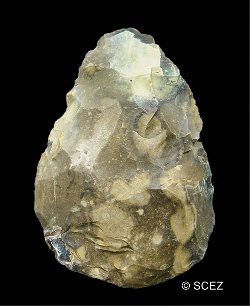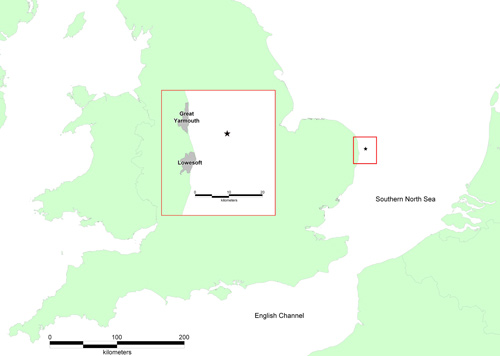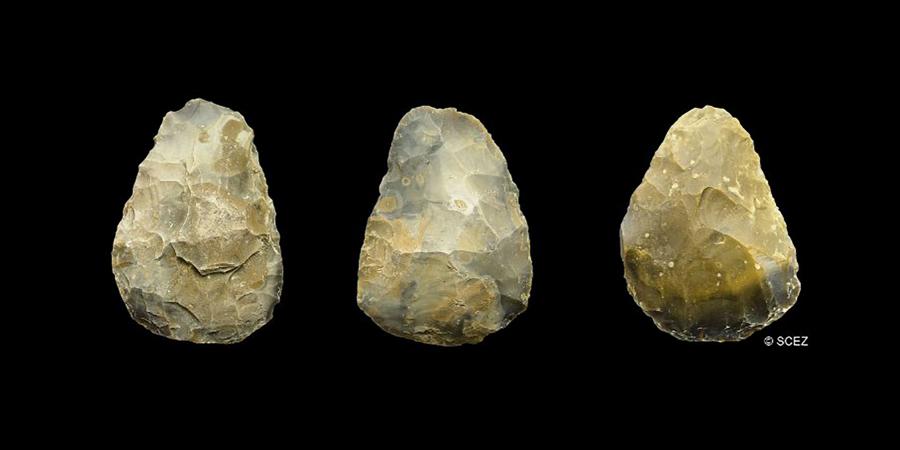What are handaxes?
Handaxes are stone tools that were used in the Ice Age. They were multi purpose tools, a bit like a modern Swiss army knife.
Twenty-eight handaxes and some smaller pieces of flint (known as flakes) were found. The remains of mammoth, including tusk fragments and teeth, and fragments of deer antler were discovered at the same time. The discovery of the handaxes was reported through a scheme set up to report archaeological finds from the sea; the BMAPA Marine Aggregate Industry Protocol for the Reporting of Finds of Archaeological Interest.
How old are they?
We know that handaxes date to the Ice Age but when within this vast length of time is not yet known. The shape of the handaxes can be compared with finds up to 100,000 years old. Archaeologists call this time the Middle Palaeolithic period. Detailed study is needed to confirm this dating.
People first lived in Britain about 700,000 years ago. Since then the climate has been affected by a series of ice ages. Massive ice sheets have spread down from the North Pole to cover parts of Britain, and retreated when the climate improved. For thousands of years the environment would have been very harsh, cold, and tundra-like. In other long periods of time the climate would have been as warm or even warmer than today. Through these changing times, generation after generation of our predecessors carved out their living.

Who made them?
If the provisional dating proves to be correct, then these tools were made by Neanderthals (Homo neanderthalensis) not by modern Homo sapiens.
The first fully developed Neanderthals emerged around 130,000 years ago and remained in Europe until 30,000 years ago. The first reconstructions of Neanderthals were based on skeletons that were crippled with arthritis, giving rise to the popular image of brutish, ape-like people. Though they were certainly robust, with broad flat noses and a short build, these were not the remains of Ape-like characteristics, but effective adaptations to living in the cold environment of the last Ice Age.
Neanderthals are known to have had the capacity for speech and language and treated their dead in ways that indicate complex thinking.
How did they come to be under the sea?
Sea level has not always been the same. It fluctuates depending on the climate. During cold periods, ice sheets form at the North and South Poles, storing water and lowering sea levels.
This means that some areas that are today submerged were once dry and people could live in them. It is very likely that these handaxes were made, used and left behind during a cold period, on land that is now under water. If the handaxes are found to have come from soils that have plant remains in them, it will confirm that they were deposited when this area was dry land.
Are handaxes a common find?
Not at all. The number of finds from the North Sea, 28, is exceptional. This shows that a lot of activity took place here during the Palaeolithic period. The only finds of similar date from the sea before this have been single handaxes found on beaches.
These types of finds are incredibly rare, given how old they are, and there are only a few similar sites known on land and - until now - none from the sea. Archaeologists have suspected that sites like this exist in the southern North Sea, though until now it could not be proven.

How would the handaxes have been made and used?
Handaxes are made by taking a natural lump of flint and carefully striking pieces off with a hammer made of stone, bone or antler. Some of the flint flakes from the North Sea could have been removed from lumps of flint while making the handaxes.
The handaxes were probably used for butchering animal carcasses, but detailed examination of the tools, and of the animal bones, may be able to give more information about these people’s lives and activities.
What do we know about the landscape in which the people lived?
At the moment we know very little about the place in which these tools were made and used. However, the relatively new appearance of the handaxes suggests that they may have been buried in a soft soil, certainly not the gravels in which many handaxes are found. Loam sediments were identified with the handaxes, and also in another load of gravel dredged from the same area. This is very exciting as microscopic plant remains in these sediments can show what type of plants were growing in the area when the handaxes were made. This can help to paint a picture of the landscape that Palaeolithic people were living in.
These studies could also tell us about the climate and environment at this time in the Palaeolithic period and help us understand how the climate changed in the past.
What do we know about the place?
The handaxes were found near to an area where we already know that there are sediments some 70 and 130,000 years old. This was in a warmer period, known as the Ipswichian interglacial.
A study by Wessex Archaeology as part of the Seabed Prehistory project funded by the ALSF immediately north of where the handaxes were found, identified deposits that were laid down between 175,000 and 116,700 years ago. These deposits were of much older than anyone had anticipated. They had to be dated using a technique called Optically Stimulated Luminescence (OSL), as radiocarbon dating is only effective to 40,000 years ago.
Currently we have no clear evidence of people having lived in or around Britain in the Ipswichian Interglacial and it has long been thought that it was a period during which Britain was uninhabited. It is very exciting to find the axes so close to an area containing Ipswichian deposits. It may prove to be an important missing piece of the jigsaw that informs us about the distant past.
What happens next?
The finds will be analysed in order to answer these questions and more. A dredging exclusion zone has been set up around the area in order to protect any further remains that may be present.
Protocol yields other important results
Over seventy discoveries have been reported by the aggregate industry since the BMAPA/EH Protocol was introduced in August 2005, totalling over 480 separate items. This is far more than anyone expected; it was thought there might be up to a dozen reports in a year.
The finds have included shipwrecks, old ship timbers, cannon balls, crashed aircraft, a telescope, mammoth tusks and other prehistoric mammal bones, and many other items. Find by find, these discoveries by the aggregate industry are helping to build up a much better picture of our rich offshore heritage.
